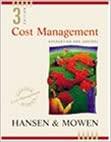Barbara Buehler, the president of Wayne Company, recently returned from a conference on quality and productivity. At
Question:
Barbara Buehler, the president of Wayne Company, recently returned from a conference on quality and productivity. At the conference, she was told that many American firms have quality costs totaling 20% to 30% of sales. She, however, was skeptical about this statistic. But even if the quality gurus were right, she was sure that her company's qual¬
ity costs were much lower probably less than 5%. On the other hand, if she was wrong, she would be passing up an opportunity to improve profits significantly and simultane¬
ously strengthen her competitive position. The possibility was at least worth exploring.
She knew that her company produced most of the information needed for quality cost reporting but there never was a need to bother with any formal quality data gathering and analysis.
This conference, however, had convinced her that a firm's profitability can increase significantly by improving quality—provided the potential for improvement exists. Thus, before committing the company to a quality improvement program, Barbara requested a preliminary estimate of the total quality costs currently being incurred. She also indicated that the costs should be classified into four categories; prevention, appraisal, internal fail¬
ure, and external failure costs. She has asked you to prepare a summary of quality costs and to compare the total costs to sales and profits. To assist you in this task, the following information has been prepared from the past year, 2001:
a. Sates revenue, $5,000,000; net income, $500,000.
b. During the year, customers returned 30,000 units needing repair. Repair cost averages
$1 per unit.
c. Four inspectors are employed, each earning an annual salary of $20,000. These 4 in¬
spectors are involved only with final inspection (product acceptance).
d. Total scrap is 50,000 units. Of this total, 60% is quality-related. The cost of scrap is about
$5 per unit.
e. Each year, approximately 150,000 units are rejected in final inspection. Of these units, 80% can be recovered through rework. The cost of rework is $0.75 per unit.
f. A customer canceled an order that would have increased profits by $50,000. The cus¬
tomer s reason for cancellation was poor product performance.
g. The company employs 3 full-time employees in its complaint department. Each earns
$13,500 a year.
h. The company gave sales allowances totaling $15,000 due to substandard products be¬
ing sent to the customer.
i. The company requires all new employees to take its 3-hour quality training program.
The estimated annual cost of the program is $10,000.
Required:
1. Prepare a simple quality cost report classifying costs by category.
2. Compute the quality cost-sales ratio. Also, compare the total quality costs with total profits. Should Barbara be concerned with the level of quality costs?
3. Prepare a pie chart for the quality costs. Discuss the distribution of quality costs among the four categories. Are they properly distributed? Explain.
4. Discuss how the company can improve its overall quality and at the same time reduce total quality costs.
5. By how much will profits increase if quahty costs are reduced to 2.5% of sales?
Step by Step Answer:

Cost Management Accounting And Control
ISBN: 9780324002324
3rd Edition
Authors: Don R. Hansen, Maryanne M. Mowen





